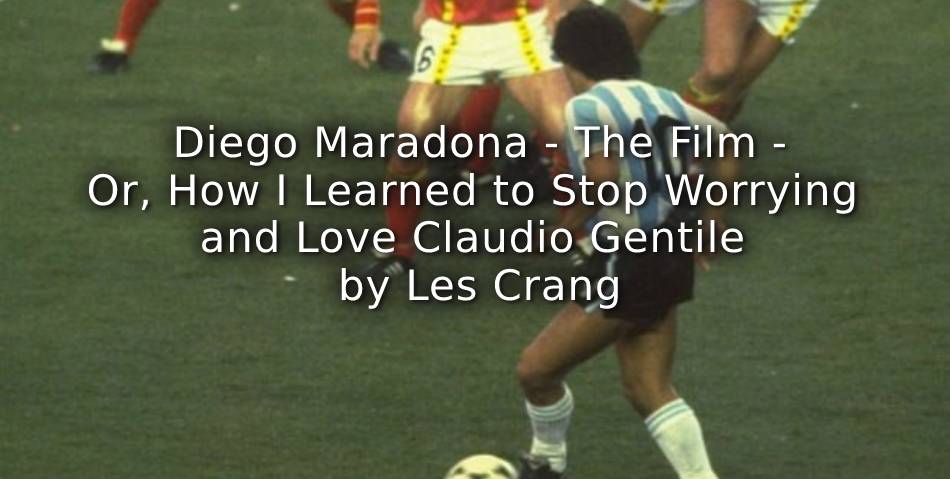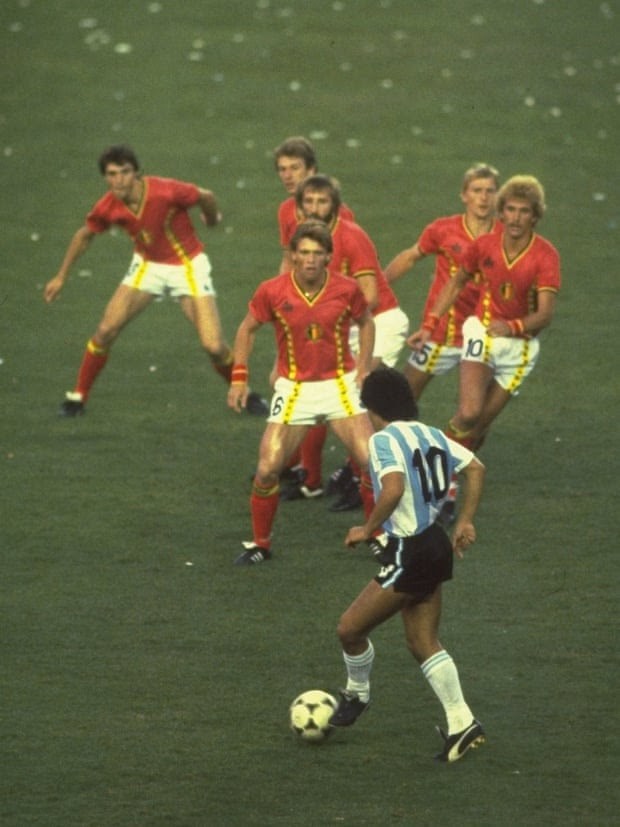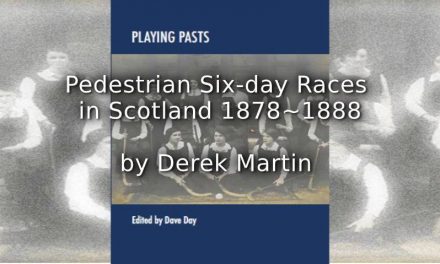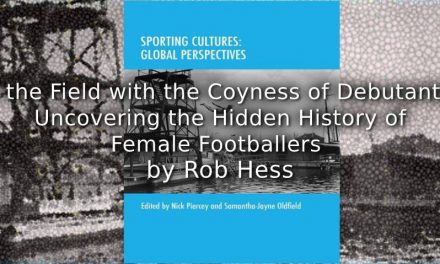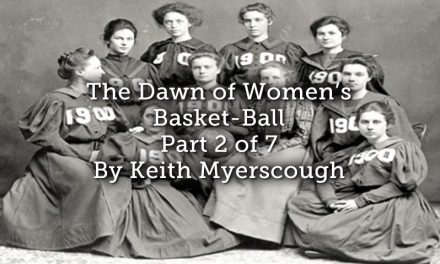Over the summer I watched by Diego Maradona by Asif Kapadia. A biographical look at the turbulent life of Argentine footballer of the title. It especially makes reference to his time in Italy with Napoli (and his use of cocaine during that period) and the importance of his World Cup finals games with Italy in 1986 and 1990. Both games ended in 1-1 draws (the latter being decided on penalties in which Argentina went on to the final, the former allowed Argentina from the group stages of the World Cup they would win). In many ways, documentary film seems to possibly portray a reality of ‘real life’. In Kapadia film he uses Italy as a canvas to project his truth. Unfortunately, it’s the absence of truth in his film that I find problematic. The reason? The World Cup of 1982 is brushed over and that, I feel, misses a significance that the film maker has overlooked within the story. That significance is the motivation of 1982 for revenge for Diego Maradona. I will explain further as we proceed.
Art or Sport both require motivation. For example, in Art motivation may be seen in novels such as Jane Austens ‘Pride and Prejudice’, in which the protagonists must confront and overcome their pride and prejudice to obtain a happy conclusion.
Within sport one could see motivation in a similar vein. For example, the motivation can have many examples. National pride for example:-
Racial and cultural pride:-
Or arrogance:-
All act as a form of motivation in obtaining ‘something’. The Greek philosopher Aristotle spoke of this within the arts:-
In Aristotle’s view, it was “the real or the apparent good” of some anticipated consequence, or image of “what is to come” derived in “reference to what is present,” that simulated a living organism to pursue it (if positive) or avoid it (if negative).
Whilst In ‘Documentary Films and the Problem of “Truth”’ (Blumberg, 1977) said:-
In motion pictures, “truth” is relative to the way it is presented.
Documentary filmmakers have always tried to represent the truth but this has always been problematic. What has been regarded as the first documentary Nanook of the North, made in 1922, the reality of Nanook , as a inuit of Quebec Canada suffers from how the director sees Nanook and his family. For example, Fatimah Tobing Rony, The Third Eye: Race, Cinema, and Ethnographic Spectacle has covered how the ‘reality’ of the film is not true to real life (Nanook is not his real name, his ‘wife’ is actually not his wife and that he most likely did not die of starvation but tuberculosis).
The problem with ‘Diego’ is that although it portrays Maradona’s motivation, it skewers it to a limited period of Diego’s career. I would suggest that Diego is not totally motivated by living and playing in Napoli, that made him an ‘outsider’. His comment prior to the 1990 World Cup semi-final between Argentina v Italy in Naples.
Diego Maradona motivation is revenge of Argentina’s defeats to Italy in the 1978 and 1982 World Cup finals . They had also played out a 1-1 draw in the 1974 finals (this is the only occurrence in World Cup history 5 games between the same side have been played consecutively).
In the 1978 World Cup, Diego Maradona was dropped from the final 22 squad for Argentina as the manager, César Luis Menotti. Journalist Carlos Ares said of this incident:-
“That day I stayed for dinner and when I left the base alone it was dark, it was very cold and I heard someone crying,” Ares recalled in the book Vivir en los Medios. “I saw the strongest image I can remember: it was Maradona, sitting next to a tree crying his eyes out. I told him what was obvious: ‘You know how many World Cups you’re going to play, right?’ But he answered me, weeping: ‘How do I tell my dad?’ He said he was never going to forgive Menotti”.
“There, when I was left out of the 22-man list, ‘because I was too young’, I started to realise that anger was a fuel for me,” Diego himself wrote in his autobiography.
This anger became more embittered when Argentina would lose in the group stages 1-0 to Italy. Their only defeat on their way to winning the World Cup, would be to Italy, when Juventus striker Roberto Bettega would score the winner.
Having been left out of the 1978 squad, Maradona was chosen to captain the under 20 side in 1979 World Cup, which they successfully won, defeating the USSR 3-1 in the final.
Maradona’s star would rise further in Europe when he played England in 1980, where his audacious talent would be more fully appreciated within an insular looking England. Although England won 3-1, it was Maradona who shone in this game. Though, if you watch this video, look at the fouls Maradona constantly faced, especially from full back Kenny Sansom. A recurring theme of Maradona’s career.
By 1982 Maradona had just joined Barcelona for a record fee of £6,900,000 and was about to be the star of the World Cup (in Spain). Unfortunately, this would be the World Cup I feel Asif Kapadia should have more fully appreciated. Is lack of discussing the 3 defeats Argentina suffered during the 1982 World Cup to Belgium, Italy and Brazil respectively.
The picture below shows Maradona marked out of the tournament by 6 Belgium defenders. The photographer of the picture, Steve Powell, said of the image:-
“It’s about communication. It communicates the power of Maradona and the fear he instilled. It’s about this one man and the relationship he had with opposing players.”
In Jonathan Wilson’s excellent ‘Angels with dirty faces : the footballing history of Argentina he says that Maradona admitted that the expectant mood in Buenos Aires meant they had arrived in Spain believing success was so necessary as to be all but inevitable. Defeat to Belgium was a wake up call that Maradona had arrived, but more with a mere whisper than a full and broad shout from Diego. It also indicated his petulance and his hatred of defeat when, at the final whistle he refused to swap shirts with the Belgium captain Eric Gerets.
The following day, Argentina would surrender to the British in the Falkland Islands. Maradona would make 1986 the year of his revenge over Belgium’s in the Semi-final:-
Although they would defeat Hungary and El Salvador, in the 1982 World Cup, they would meet Italy and the pre-tournament favourites Brazil.
The first game they played would be against Italy, who had been, at best, moribund and only qualified via goal difference into the round robin stage of the finals. They were also famous for what has been termed ‘Catenaccio‘ style football. A style created at Inter Milan in the 1960’s with its chief exponent being the Argentine Helenio Herrera and depended much upon tight defence, playing from the back to counter and goal poaching strikers. Jonathan Wilson has described this style as ‘in the popular imagination, all that was wrong with football.’ Aggressive, negative and sterile.
If any team would represent this more, it was Juventus, whose spine ran through the Italian defence. In goal, Dino Zoff, 40 years old and captain, midfield general was Marco Tardelli, in central defence was probably, alongside Paolo Maldini and Franco Baresi of a later generation was Gaetano Scirea, balanced and agile. Then, their was another defender, much maligned but for man marking a limpet and for tackling like King Kong. Claudio Gentile. Born in Libya he was called Gaddafi. His display on Maradona was sensational. His trips, nudges and tight marking made Maradona look pedestrian. He was shackled and humiliated by Gentile. Kapidia, in painting over this incident. After the game, Gentile said of his display he was not there to perform like a ballerina. The display was similar to how the England team had reacted towards Maradona in 1980.
The Italian football journalist Gianni Brera wrote afterwards:-
Maradona has once more learned that football has its axioms: one of which is as follows: that you can be the god of the pelota on earth, but if a Gentile does not let you touch it, you are a god who leave the ball to Gentile.
The journalist also revealed that he Gentile ‘wound’ Maradona up by rubbing his testicles against him in the first half of the game.
Again, I feel that revenge is always a motivating factor and one that Asif Kapadia indicates in the Maradona documentary, but nothing is said of 1982. Kapaidia instead focussed on cocaine and his illegitimate son Diego Sinagra. His motivation for revenge on the Italian team was certainly strong, as he felt he never earnt the respect he craved playing for a southern Italian club like Napoli. His taunt to Italy, whom they played in the Semi-final in 1990 in his home club town of Naples that :-
Neapolitans you shouldn’t forget that in Italy they do not consider you to be Italians. The country comes and asks for your support for just one day of the year, and for the other 364 they’ll call you Africans. It is true that wherever we travel they call us Africans.
Although Kapadia does discuss Maradona’s time with Napoli, he discusses the victories that Maradona bought both his club and national team. The defeat to Italy in 1982 and especially to a team which consisted of Juventus players would certain motivate Maradona. John Foot’s book Calcio: A History of Italian Football has extensive amount of it discuss’ how Juventus are the biggest club in Italy and the most despised. For example Fiorentina fans anti-Juventus feeling is seen in the statement they are ‘zona anti-gobbizzata’ :-
Or to any non-Italian speaker, ‘Anti-Hunchback Zone’. The origin of such a slight lies in reference to the rather absurd nickname Florence has bestowed upon Juventini, ‘Hunchbacks’. Such a slander contains various roots, with it commonly being a reference to the fact that Juventus have the weight of stolen titles on their back.
The Northern Italian clubs of Juventus, Internazionale and AC Milan have often been disparaging of Naples, which is mentioned in the documentary, but Diego’s shackling by Juventus defender Claudio Gentile must have also been a motivation in his desire to win in Italy. The desire to win for Argentina was certainly seen in the 1990 World Cup final when the Argentinian national anthem was roundly booed with Maradona telling the camera what he thought of this.
Finally, Brazil. The relationship between these two nations has always been one of rivalries. Economically, population wise and especially on the football world. By 1978, Argentina had won only 1 World Cup, whilst Brazil had won 3 and Uruguay had won two. Brazil are the natural ‘enemies’ of the Argentina team, as indicated by advert below, in which Diego is seen dressed in a Brazil shirt sing their national anthem, only to wake up and realise its a nightmare.
Ironically, Argentina and Brazil had played each other in the 1974 and 1978 World Cup (with Brazil winning the first 2-1 and drawing the second 0-0). The 1982 game, came after the defeat to Italy and Argentina needed to win and win well over the tournament favourites Brazil or face elimination. Unfortunately, this Brazil team had some excellent midfielders (and a dire goalkeeper and a worst striker in Serginho). The 3-1 defeat to Brazil would end with Maradona kicking out at Batista and receiving a red card for his petulance.
The game in 1990 with Brazil, much had been written of how poor the Brazilians had been in the group stage, scoring a mere four goals. When they meet in the round of the last 16, much has been written of unpaid bar bills and internal wrangling in the Brazilian squad. Compare this to Argentina squad, which was hoping Maradona would be able to play due to an ankle injury. Ironically, I remembered the game, especially the first half. Brazil dominated, hitting the bar on numerous occasions and Maradona was heavily man marked. By the second half, Brazil had started to run out of steam. In the 81st minute Maradona, marked by 2 players pulled through, leaving a gap for Canniga to pull free. Maradona played a slide pass ball, taking out two defenders and allowing Canniga to round the keeper. 1-0 Argentina and their first win in Brazil in the World Cup finals.
Afterwards Maradona said:-
Beating brazil is lovely. Brazil have sold the world this idea that they are the only ones capable of jogo bonito…..Bollocks.
The motivation of revenge seems certainly here to me, especially after the defeat in 1982.
In conclusion, Asif Kapadia documentary is problematic. It’s missing out on the 1982 World Cup a blindingly obvious error on the ‘motivation’ for Maradona. That of revenge.
The will to win has always been a contributing factor. Archetti, said in discussing Maradona that he was :-
A sport hero is an idol and an icon who belongs to a specific time. The time of heroes.
I feel that the documentary by Asif Kapadia certainly is impacted upon this. In many ways, the documentary looks at the story of the 1980s cinematography. The cocaine, violence and ‘foreign’ impact of cocaine seen in Scarface:-
The excesses of consumer capitalism in Wall Street:-
The will to be the sporting best at any cost may be seen in Rocky IV, with the character of Ivan Drago:-
Maradona is a good film, but don’t expect accuracy or, heaven forbid, ‘the truth’ that a documentary is alleged to give. This is purely entertainment.
References
- Andrews, D. and Jackson, S. (2001). Sport stars. 1st ed. London: Routledge.
- Brera, G. (1982). Mondiali 1982: Miracolo a Barcellona – Storie di Calcio. [online] Storiedicalcio.altervista.org. Available at: https://storiedicalcio.altervista.org/blog/italia_1982_argentina_brera.html [Accessed 28 Nov. 2019].
- Campomar, A. (2015). ¡Golazo! : A History of Latin American Football. 1st ed. London: Querbus.
- Edwards, D. (2019). Maradona at 1979 FIFA World Youth Championship: How Diego was used by Argentina’s murderous dictatorship | Goal.com. [online] Goal.com. Available at: https://www.goal.com/en/news/maradonas-first-world-cup-how-diego-was-used-by-argentinas/21s561hd9y231wgngbf83hvtr [Accessed 28 Nov. 2019].
- Foot, J. (2007). Calcio. 1st ed. London: Harper Perennial.
- Hart, S. (2018). World in motion. 1st ed. LONDON: De Coubertin Books.
- Rony, F. (1996). Third Eye : Race, Cinema, and Ethnographic Spectacle. 1st ed. Durham, NC, USA: Duke University Press.
- Stevens, J. (2017). Purple haze over Juve | Football Italia. [online] Football-italia.net. Available at: https://www.football-italia.net/110085/purple-haze-over-juve [Accessed 28 Nov. 2019].
- Vulliamy, E. (2019). Maradona and Naples created an unearthly and sometimes dark magic. I was there | Ed Vulliamy. [online] the Guardian. Available at: https://www.theguardian.com/commentisfree/2019/jun/07/maradona-naples-documentary [Accessed 28 Nov. 2019].
- Weeks, J. (2014). Diego Maradona against Belgium: the real story behind the famous image | Jonny Weeks. [online] the Guardian. Available at: https://www.theguardian.com/football/blog/2014/jul/05/diego-maradona-belgium-famous-photo [Accessed 28 Nov. 2019].
- Williams, B. (2008). Life and crimes of Diego Armando Maradona. [online] Telegraph.co.uk. Available at: https://www.telegraph.co.uk/sport/football/international/3278819/Life-and-crimes-of-Diego-Armando-Maradona-Football.html [Accessed 28 Nov. 2019].
- Wilson, J. (2010). Inverting the Pyramid: The History of Football Tactics. 1st ed. London: Orion.
- Wilson, J. (2016). Angels with dirty faces : the footballing history of Argentina. 1st ed. London: Orion.

